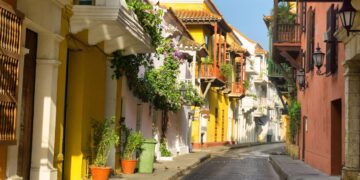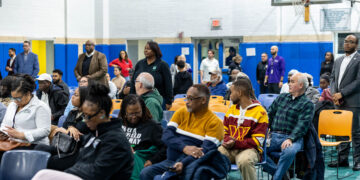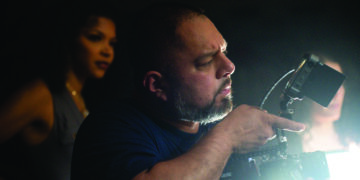In 1988, Southwest Detroit and its Latino community was in the national spotlight. How did that come to be? Those who are familiar with Salsa and Latin Jazz history may recognize the name of the bandleader and singer Machito. His full name was Francisco Raul Griollo. In collaboration with his brother in law, Mario Bauza, he was instrumental in the formation of both Latin Jazz and Mambo. The nation’s first memorial concert was held in Detroit!
A well known singer since the 1920’s, Machito would go on to form the groundbreaking orchestra “Machito y Sus Afro Cubanos” in 1940. Born in Cuba in 1909 he sang in a number of famous ensembles there between 1928 and 1937. When he moved to New York City in 1937 he joined Bauzá, who already had gained recognition for his work as the musical director of a number of African-American jazz big bands. Those bands included historic figures like Cab Calloway, Fletcher Henderson, and Chick Webb. Bauza went on to introduce jazz trumpeter extraordinaire Dizzy Gillespie and vocalist Sarah Vaughan to some of these bands. Bauza’s jazz pedigree was well established by the time the Machito y Sus AfroCubanos was formed. The music played by the band would go on to inspire many jazz greats such as Dizzy Gillespie, Charlie Parker, George Shearing and Stan Kenton among others.
Machito and Bauza blended Cuban and Puerto Rican sounds with big band Afro-American Jazz to develop musical forms that would become known as Latin Jazz and mambo. A New York Latin experience and tradition that would go on to become the world rage. A number of music greats like Tito Puente, who played at the age of 15 with Machito, were incubated in this groundbreaking band. Later on, Tito Puente, Tito Rodriguez and Machito’s Afro Cubanos would bring in the golden age of Mambo during their tenure at the Palladium Dancehall in New York City from the late 40’s through the early 60’s. Latin music would never be the same!
Given this historic contribution a number of Detroit musicians and cultural activists were puzzled that a national memorial concert had not been organized for Machito after his death on April 15, 1984. In 1983, after decades of musical brilliance and being nominated twice before, Machito finally won a Grammy for a recording done in the Netherlands. The following year he would pass. His legacy is maintained by son Mario Griollo, who continues to lead the Machito Orchestra to this date.
Facing what they considered to be a major oversight, members of Palante Productions Francisco Mora, Bernadette Dickerson, and yours truly decided this had to be corrected. They reached out to Andy and Jerry Gonzalez famed New York Salsa and Jazz musicians and Mario Griollo to begin the work of organizing the first National Machito Memorial Concert. Casa de Unidad, the premier Latino arts organization at the time played a key supporting role. The New York side of the organizing effort was handled by Andy Gonzalez and Mario. The target month selected for the event was April 1988, in order to celebrate the four year anniversary of Machito’s death.
To insure significant community turnout they knew they needed an educational campaign about Machito’s historic role. Critical to this was the formation of a committee that included educators, community agencies, youth, musicians and artists from not only Southwest Detroit but also from across the broader music community. After a year and a half of comprehensive educational and organizing efforts, the concert was held April 23, 1988, at Orchestra Hall, current home to the Detroit Symphony Orchestra.
Three radio stations collaborated in promoting the event and were represented by their respective Latin music program hosts. Detroit’s jazz station WJZZ by Club Caliente program host Carmen Garcia, Public Radio WDET by Latin Quarter program host and the station’s music director Jose Gomez and Detroit Public School’s WDTR, 90.9 FM by Ozzie Rivera, program host for Caribe Serenade. The three jointly emceed the night’s festivities.
Detroit jazz greats like drummer JC Heard, trumpet master Marcus Belgraves joined New York brothers Andy and Jerry Gonzalez on bass and congas respectively, Nikki Marrero famed timbalero and Ismael Miranda who flew in from Puerto Rico to join Mario’s sister Paula on vocals. Marrero and Miranda’s key roles with the Fania All-Stars is well known to salsa aficionados. Veteran musicians from Detroit’s jazz and New York’s salsa music communities rounded out the 20 plus orchestra.
A sold-out crowd of over 1,000 individuals filled the hall. A high percentage were current and former Southwest Detroit residents. All knew history was being made, especially because the venue was not typically associated with the vibrant Detroit Latin dance scene of the time. The atmosphere was electric from the very first song and continued throughout the almost 2-hour concert. Audience members chimed in singing well known choruses and occasionally got up in the aisles and danced their hearts away. New York mambo dancers Ernie Ensley and Ana Anaya excited the crowd with their electrifying performance adding even more spice to the evening.
That night Detroit’s Latino community enjoyed the national spotlight. I still run into people who excitedly reflect on their attendance then and their pride they were able to revel in the national attention. They realize history had been made.
BIO: Ozzie Rivera, a retired social worker, is a cultural activist and musician who currently teaches on Afro-Latino History and Culture at Wayne State University and social work at the University of Michigan.














































